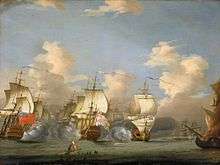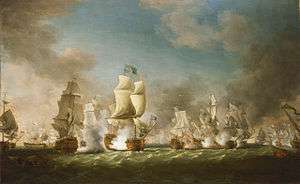Battle of Cape Passaro
| ||||||||||||||||||||||||||||||
The Battle of Cape Passaro (or Passero) was the defeat of a Spanish fleet under Admirals Antonio de Gaztañeta and Fernando Chacón by a British fleet under Admiral George Byng, near Cape Passero, Sicily, on 11 August 1718, four months before the War of the Quadruple Alliance was formally declared.
Background
Tensions between Spain and Britain were high. On 2 August 1718 the Quadruple Alliance consisting of the Holy Roman Empire, Kingdom of France, Kingdom of Great Britain and the Republic of the Seven United Netherlands, demanded that the Spanish withdraw their invading forces from Sicily and Sardinia. The British fleet had landed a small Austrian army near Messina, which began besieging that city which was controlled by the Spanish.
Battle

The men-of-war of the Spanish fleet were made up of eleven ships of the line of 50 guns or above, ten frigates, four bomb vessels, two fireships and seven galleys; the rest were merchantmen with stores and provisions.
The fleet was sailing in a scattered way and it sensed no danger when it caught sight of the British ships because it was unaware of the Quadruple Alliance's ultimatum. When the British fleet began to approach in an aggressive way, the Spanish fleet split into two – the smaller ships and merchantmen made for the coast, while the larger men-of-war engaged the British as they came up. HMS Canterbury, under George Walton was detached along with HMS Argyll, HMS Burford and four other ships to chase the first group and captured most of them. These captured Spanish warships were afterwards laid up in Minorca.
A shipwreck has been found (2012) just off Avola, near the south-eastern tip of Sicily. Cannon have been raised from the wreck identifying it as a British ship, probably one sunk in this battle. The location of the wreck helps to pinpoint the site of the battle.[2]
Aftermath
Four months later on 17 December 1718, France, Britain and Austria declared war on Spain, starting the War of the Quadruple Alliance. The Netherlands joined them later, declaring war on Spain in August 1719.
Thwarted by Spanish interference, the besieging Austrian army captured Messina the next year, and destroyed the remaining Spanish ships in the harbour. These events combined to eventually force the Spanish king to accept the terms of the Quadruple Alliance in 1720.
Byng was rewarded handsomely for this victory by King George I of Great Britain, and given full power to negotiate with the various princes and states of Italy, on behalf of the British crown. On his return to England in 1721, he was made Rear-Admiral of Great Britain, a member of the Privy Council, and ennobled as Baron Byng of Southill and 1st Viscount Torrington, in Devon.
Of the ships captured in this battle, the Principe de Asturias had formerly been the British 80-gun ship Cumberland, captured by the French in 1707 and later sold to Spain; after the Battle of Cape Passaro, she was sold to Austria. In 1731 the British offered to return the other captured ships laid up in Minorca, but they were found to be rotten and were broken up instead.
Order of Battle
Britain (Sir George Byng)
- Barfleur 90 (flag of Admiral Sir George Byng, 1st Captain George Saunders, 2nd Captain Richard Lestock)
- Shrewsbury 80 (Vice-Admiral Charles Cornwall, Captain John Balchen)
- Dorsetshire 80 (Rear-Admiral George Delaval, Captain John Furzer)
- Breda 70 (Barrow Harris)
- Burford 70 (Charles Vanbrugh)
- Captain 70 (Archibald Hamilton)
- Essex 70 (Richard Rowzier)
- Grafton 70 (Nicholas Haddock)
- Kent 70 (Thomas Mathews)
- Lenox 70 (Charles Strickland)
- Orford 70 (Edward Falkingham)
- Royal Oak 70 (Thomas Kempthorne)
- Canterbury 60 (George Walton)
- Dreadnought 60 (William Haddock)
- Dunkirk 60 (Francis Drake)
- Montagu 60 (Thomas Beverley)
- Rippon 60 (Christopher O'Brien)
- Rupert 60 (Arthur Field)
- Superb 60 (Streynsham Master)
- Rochester 50 (Joseph Winder)
- Argyll 50 (Conningsby Norbury)
- Charles Galley 44 (Philip Vanbrugh)
Total was 1 of 90 guns, 2 of 80 guns, 9 of 70 guns, 7 of 60 guns, 2 of 50 guns, 1 of 44 guns. The British fleet also comprised 6 smaller vessels – the fireships Garland (Samuel Atkins) and Griffin (Humphrey Orme), the storeship Success (Francis Knighton), the hospital ship Looe (Timothy Splaine), the bomb-ketch Basilisk (John Hubbard) and an unnamed bomb tender.
Spain (Vice-Admiral Don José Antonio de Gaztañeta)
- Real San Felipe (El Real) 74 (flag) – Captured by Superbe and Kent, blew up after being towed to Mahon
- Principe de Asturias 70 (Rear-Admiral Don Fernando Chacón) – Captured by Breda and Captain
- San Juan Bautista 60 (Don Francisco Guerrero) – Escaped to Malta.
- San Luis 60 (Rear-Admiral Don Balthasar de Guevara) – Escaped to Malta.
- San Pedro 60 (Don Antonio de Arizaga) – Escaped
- San Carlos 60 (Prince de Chalois) – Captured by Kent
- Real Mazi (El Real) 60 (Rear-Admiral Marquiss de Mari) – Captured by Canterbury's division
- San Fernando 60 (Rear-Admiral George Cammock) – Escaped to Malta
- Santa Isabel(la) / San Isabel 60 (Don Andrea Reggio) – Captured by Dorsetshire
- Santa Rosa 60 (Don Antonio González) – Captured by Orford
- Perla de España 54 (Don Gabriel de Alderete) – Escaped to Malta
- San Isidro 46 (Don Manuel de Villavicencio) – Captured by Canterbury's division
- Hermione 44 (Don Rodrigo de Torres) – Escaped, but then burnt at Messina
- Volante 44 (Don Antonio Escudero) – Captured by Montagu and Rupert
- Esperanza 46 (Don Juan Maria Delfin) – Burnt to escape capture
- Juno 36 (Don Pedro Moyano) – Captured by Essex
- Sorpresa 36 (Don Miguel de Sada, count of Clavijo) – Captured by Canterbury's division
- Galera 30 (Don Francisco Álvarez Barreiro) – Escaped
- Castilla 30 (Don Francisco de Liaño) – Escaped
- Conde de Tolosa 30 (Don José de Goycoechea) – Escaped, but then captured at Messina
- Aguila 24 (Don Lucas Masnata) – Captured by Canterbury's division
Total was one 74-gun, 1 70-gun, 8 60-gun, 1 54-gun, 2 46-gun, 2 44-gun, 2 36-gun, 3 30-gun, 3 26-gun, 1–24 gun and 13 other ships.
See also
References
- 1 2 Gaston Bodart: Militär-historisches Kriegs-Lexikon, (1618-1905). Wien, 1908 pg. 176 (German)
- ↑ In pictures: British guns lifted from wreck off Sicily, BBC
Sources
- Trafalgar and the Spanish Navy (1988)
- Pattee Byng's Journal 1718–1720 (1950)
External links
- Nieuwe Afteekening van het Eyland en Koninkryk Sicilia Vertoonende alle desselfs Zee Havenen Anker Plaetsen Riviere Dieptens Klippen Steeden en Vastigheeden. Dutch antique nautical chart of Sicily (1724) with scenes from the Battle of Cape Passaro by cartographer Gerard van Keulen.
Coordinates: 36°41′13″N 15°08′54″E / 36.6869°N 15.1483°E
